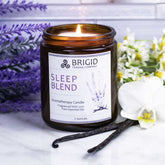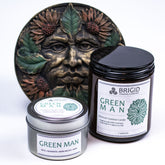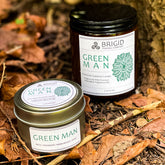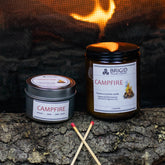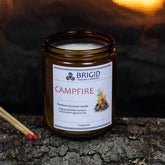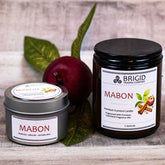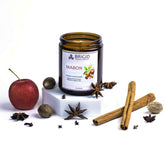Samhain: How to Celebrate The Ancient Irish Origin of Halloween
Samhain: The Veil is Thin
The shadows have grown long, and the nights have grown deep and dark. The last harvests have been taken, and the wintry approach of Yule has just begun to approach. As the light and warmth of summer and early autumn disappear into memory, the beginning of the Celtic winter arrives. Soon it will be November 1st, and with it will come Samhain, the liminal point before the world plunges into the darkness of winter.
Cultures across the world have celebrated the midpoint between the Autumn Equinox and the Winter Solstice, giving it their own names. Among the Celts of Europe, this time was Samhain (pronounced SOW-in), an Irish word which means, approximately, "the meeting at the end of summer." More than just a festival, Samhain marked both an ending and a beginning: the close of the harvest season, and the turning of the new year in the Celtic calendar.
The Origins of Samhain
Samhain was one of the four great fire festivals of the Celtic year, alongside Imbolc, Beltane, and Lughnasadh. It took place at the midpoint between the autumn equinox and the winter solstice, generally the night between October 31st to November 1st.
For the Celts, Samhain was not only agricultural but deeply spiritual. It was believed that the veil between the worlds of the living and the dead grew thin during this liminal time. Ancestral spirits could return to visit their families, while humans had an opportunity to seek guidance or omens for the year ahead. Bonfires were lit, offerings of food and drink were left out, and people donned sinister masks and costumes to ward off unpleasant apparitions.
Of Gods and Ancestors
Of all the holy days on the Celtic calendar, Samhain is the one most closely connected with the Morrigan. This fearsome goddess often appeared as one of three visages, a common trait among Celtic gods and goddesses. Her visages, typically known as the Badb, Macha, and Nemain. In these forms, the Morrigan represented traits as diverse as warfare, death, fate, destiny, and rightful sovereignty, among others.
Dwelling as she does in the Otherworld with the rest of the Sidhe, the prehistoric gods of Ireland, the Morrigan's role as a goddess who stands between life and death mirrors the liminal quality of Samhain, as the veil between the two worlds becomes thinnest and easiest to cross. In ancient traditions, it was Samhain when the Morrigan would appear to offer prophecies on the fates of warriors and kings. Local legend holds that the Morrigan flew forth from Oweynagat, or the Cave of the Cats, on Samhain, close to the prehistoric home of the legendary Queen Medb.
For the Celts, this night wasn't just about gods and myths. It was also about family since departed, as the veil being thin meant that the spirits of ancestors and loved ones could come back to spend time with family again, if only for one night. At feasts, places would be set for the dearly departed, and offerings were made at altars when the sun went down. From them, the living could learn about what was foretold for the season to come, what harvests to plant, and who would die over winter, among other grim but vital questions.
Holy Hallowe'en
Rooted as it was in pre-Christian Celtic beliefs, Samhain was just one of the many harvest and fire festivals which had to change when Christianity came to their lands. The early Church sought to reframe existing pagan festivals, often either genericizing them as harvest festivals or dedicating them to saints and martyrs. In the 9th century, All Saints’ Day (November 1st) and All Souls’ Day (November 2nd) were established, creating a Christian tradition of prayer and remembrance around the same time. The night before, All Hallows’ Eve, gradually took on many of the older customs of Samhain, as they proved impossible for the Church to stamp out.
Over centuries, these All Hallows' Eve traditions blended and traveled throughout the Europe and beyond. In medieval Europe, “souling” involved going door-to-door offering prayers for the dead in exchange for food. Yet it wasn't until the Age of Immigration and the arrival of Irish and Scottish immigrants in the United States that such customs were brought to North America. In the 19th century, as consumer culture began to take hold in the Victorian Era and beyond, these practices began to evolve into what we now call Halloween.

Why Samhain Still Matters
In the fast-paced modern world, occasions like Samhain matter more than ever. Reaching far beyond the costumes and candy of Halloween, Samhain is a call to pause and recognize the passage of time. Samhain is a festival of continuity as well as change, a recognition that the living are always in conversation with the dead, often in surprising and subtle ways. By honoring our ancestors, we root ourselves in a common lineage, one which unites us to the rest of our human family.
Samhain is a time for listening, a rare quality in a media-saturated environment. Many cultures hold that when the veil between worlds grows thin, the voices of the departed are easiest to hear. The wisdom of past generations may come to us in unexpected memories, in dreams, or in quiet moments of reflection. By making space for silence and remembrance, we open ourselves to the lessons that endure beyond death, guidance that can help us navigate the present with greater clarity and resilience.
Samhain also invites us to acknowledge the transitory nature of life itself. The changing leaves, the long nights, and the fading warmth are all reminders of impermanence. Rather than turning away from this truth, Samhain encourages us to embrace it. To acknowledge mortality is not to despair, but to live more fully, to love more deeply, and to release what no longer serves us, finding meaning in growth.
Connecting with Samhain Today - Traditional and Untraditional Ways to Celebrate Samhain
Whether you approach Samhain as a cultural festival, a spiritual practice, or simply as a seasonal observance, there are meaningful ways to honor it beyond candy and costumes:
- Share treats - or exchange tricks
- Create an altar. Always a good option for a fire festival. Light a candle for loved ones who have passed, display their photos, or cook a favorite family recipe. Remember them warmly.
-
Host a "Dumb Supper" - share a meal in silence, lit by candlelight, places set, shared with your ancestors. You can leave the food outside as an offering after the meal is finished.
- Food and feasting is a traditional way to celebrate, whether alone or socially. Making symbolic offerings like apples, pumpkins, root vegetables, milk, bread, and wine are common in traditional practices, left on loved ones' graves or placed in special location (fireplace mantel, left near outdoor trees or on stumps).
- Sharing drinks is another way to celebrate, whether wine, beer, tea, or other choice.
- Spend time in nature. Bundle up and brave the cold. Reflect on the cycles of passing and return in the natural world as the year darkens.
- Have a bonfire. Fire was central to ancient Samhain. Use it as a symbol of warmth, protection, and renewal. Write down any messages you want to send to loved ones since passed on and cast them into the fire.
- Visit a cemetery - go to a graveyard and clean the graves of departed loved ones, leave gifts like flowers or coins.
- Indulge in some divination. Traditional Samhain was a favored time for scrying, tarot, or other forms of seeking insight for the year ahead. Seek out a tarot reader and inquire as to what the future holds.
- Share stories. Just as the Celts passed on myths and ancestral tales, take time to share family history or folklore with loved ones. Learn a ghost story and tell it for friends around a fire.
Unique Gifts for Samhain / Halloween
- Our Samhain Collection, of course!
- Craft Corn Dollies for Samhain if crops have lasted this long. Created with the last sheaf of grain, the corn dolly is kept in the home over the winter, and returned to the earth in the sprint to ensure a good harvest the following year. These are generally harvested between Lughnasadh / Lammas (first harvest), Mabon (second harvest), or Samhain (third and last harvest), especially in Ireland.
- Burning candles, cleansing spaces with incense, building bonfires, and more.
- Food and other handmade gifts, like knitted clothing or handmade decorations.
-
Dried flower arrangements, flowers, or other indoor-friendly nature activity (arrange moss gardens?)


